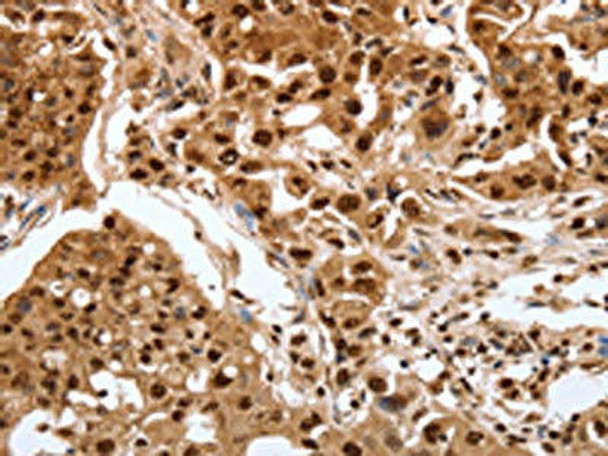SRF Antibody (PACO18434)
- SKU:
- PACO18434
- Product type:
- Antibody
- Reactivity:
- Human
- Mouse
- Host Species:
- Rabbit
- Isotype:
- IgG
- Application:
- ELISA
- Application:
- WB
- Application:
- IHC
- Antibody type:
- Polyclonal
- Conjugation:
- Unconjugated
Description
| Antibody Name: | SRF Antibody (PACO18434) |
| Antibody SKU: | PACO18434 |
| Size: | 50ul |
| Host Species: | Rabbit |
| Tested Applications: | ELISA, WB, IHC |
| Recommended Dilutions: | ELISA:1:2000-1:5000, WB:1:200-1:1000, IHC:1:50-1:200 |
| Species Reactivity: | Human, Mouse |
| Immunogen: | Synthetic peptide of human SRF |
| Form: | Liquid |
| Storage Buffer: | -20°C, pH7.4 PBS, 0.05% NaN3, 40% Glycerol |
| Purification Method: | Antigen affinity purification |
| Clonality: | Polyclonal |
| Isotype: | IgG |
| Conjugate: | Non-conjugated |
 | The image on the left is immunohistochemistry of paraffin-embedded Human lung cancer tissue using PACO18434(SRF Antibody) at dilution 1/30, on the right is treated with synthetic peptide. (Original magnification: x200). |
 | Gel: 10%SDS-PAGE, Lysate: 50 μg, Lane 1-2: HT29 cells, Jurkat cells, Primary antibody: PACO18434(SRF Antibody) at dilution 1/400, Secondary antibody: Goat anti rabbit IgG at 1/8000 dilution, Exposure time: 1 minute. |
 | The image on the left is immunohistochemistry of paraffin-embedded Human cervical cancer tissue using PACO18434(SRF Antibody) at dilution 1/30, on the right is treated with synthetic peptide. (Original magnification: x200). |
| Background: | This gene encodes a ubiquitous nuclear protein that stimulates both cell proliferation and differentiation. It is a member of the MADS (MCM1, Agamous, Deficiens, and SRF) box superfamily of transcription factors. This protein binds to the serum response element (SRE) in the promoter region of target genes. This protein regulates the activity of many immediate-early genes, for example c-fos, and thereby participates in cell cycle regulation, apoptosis, cell growth, and cell differentiation. This gene is the downstream target of many pathways; for example, the mitogen-activated protein kinase pathway (MAPK) that acts through the ternary complex factors (TCFs). |
| Synonyms: | serum response factor (c-fos serum response element-binding transcription factor) |
| UniProt Protein Function: | SRF: a transcription factor of the MADS domain family that binds to the serum response element (SRE). Regulates the transcription of immediate early genes including c-fos. Binds DNA as a multimer, probably a dimer. |
| UniProt Protein Details: | Protein type:Transcription factor; Motility/polarity/chemotaxis Chromosomal Location of Human Ortholog: 6p21.1 Cellular Component: cytoplasm; nuclear chromatin; nucleoplasm; nucleus Molecular Function:chromatin DNA binding; histone deacetylase binding; protein binding; protein homodimerization activity; RNA polymerase II transcription factor activity, enhancer binding; transcription factor activity; transcription factor binding Biological Process: angiogenesis involved in wound healing; associative learning; cardiac myofibril assembly; cell migration during sprouting angiogenesis; cell-matrix adhesion; developmental growth; erythrocyte development; heart development; heart looping; hippocampus development; long-term memory; mesoderm formation; morphogenesis of an epithelial sheet; mRNA transcription from RNA polymerase II promoter; muscle maintenance; negative regulation of cell migration; negative regulation of cell proliferation; neurite development; neuron development; neuron migration; patterning of blood vessels; platelet activation; platelet formation; positive regulation of axon extension; positive regulation of cell differentiation; positive regulation of filopodium formation; positive regulation of smooth muscle contraction; positive regulation of transcription by glucose; positive regulation of transcription factor activity; positive regulation of transcription from RNA polymerase II promoter; positive thymic T cell selection; regulation of cell adhesion; regulation of smooth muscle cell differentiation; regulation of water loss via skin; response to cytokine stimulus; response to hormone stimulus; response to hypoxia; response to toxin; sarcomere organization; skin morphogenesis; small GTPase mediated signal transduction; stress fiber formation; tangential migration from the subventricular zone to the olfactory bulb; thymus development; thyroid gland development; transcription from RNA polymerase II promoter; trophectodermal cell differentiation |
| NCBI Summary: | This gene encodes a ubiquitous nuclear protein that stimulates both cell proliferation and differentiation. It is a member of the MADS (MCM1, Agamous, Deficiens, and SRF) box superfamily of transcription factors. This protein binds to the serum response element (SRE) in the promoter region of target genes. This protein regulates the activity of many immediate-early genes, for example c-fos, and thereby participates in cell cycle regulation, apoptosis, cell growth, and cell differentiation. This gene is the downstream target of many pathways; for example, the mitogen-activated protein kinase pathway (MAPK) that acts through the ternary complex factors (TCFs). Two transcript variants encoding different isoforms have been found for this gene. [provided by RefSeq, May 2014] |
| UniProt Code: | P11831 |
| NCBI GenInfo Identifier: | 134876 |
| NCBI Gene ID: | 6722 |
| NCBI Accession: | P11831.1 |
| UniProt Secondary Accession: | P11831,Q5T648, |
| UniProt Related Accession: | P11831 |
| Molecular Weight: | 51,593 Da |
| NCBI Full Name: | Serum response factor |
| NCBI Synonym Full Names: | serum response factor |
| NCBI Official Symbol: | SRF |
| NCBI Official Synonym Symbols: | MCM1 |
| NCBI Protein Information: | serum response factor |
| UniProt Protein Name: | Serum response factor |
| Protein Family: | Serum response factor |
| UniProt Gene Name: | SRF |
| UniProt Entry Name: | SRF_HUMAN |
| Secondary Antibody |
| Anti-HRP Goat Anti-Rabbit IgG (H+L) Antibody (CABS014) |
| Recommended Products |
| Anti-FITC Goat Anti-Rabbit IgG (H+L) Antibody (CABS011) |
| Anti-HRP-conjugated Beta Actin Antibody (CABC028) |










